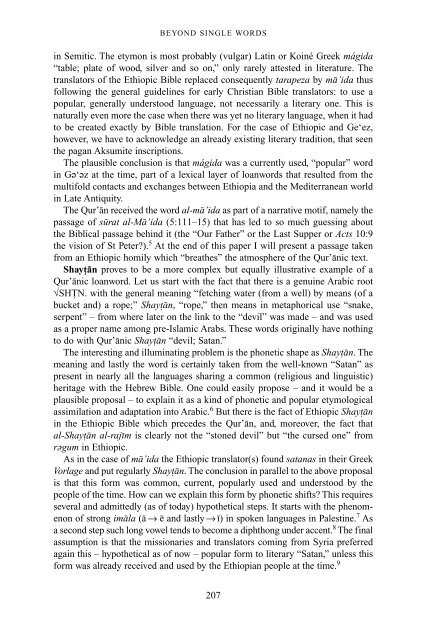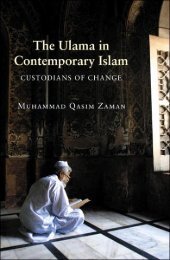The Qur'an in its historical context (pdf - Islam and Christian-Muslim ...
The Qur'an in its historical context (pdf - Islam and Christian-Muslim ...
The Qur'an in its historical context (pdf - Islam and Christian-Muslim ...
You also want an ePaper? Increase the reach of your titles
YUMPU automatically turns print PDFs into web optimized ePapers that Google loves.
BEYOND SINGLE WORDS<br />
<strong>in</strong> Semitic. <strong>The</strong> etymon is most probably (vulgar) Lat<strong>in</strong> or Ko<strong>in</strong>é Greek mágida<br />
“table; plate of wood, silver <strong>and</strong> so on,” only rarely attested <strong>in</strong> literature. <strong>The</strong><br />
translators of the Ethiopic Bible replaced consequently tarapeza by ma’ida thus<br />
follow<strong>in</strong>g the general guidel<strong>in</strong>es for early <strong>Christian</strong> Bible translators: to use a<br />
popular, generally understood language, not necessarily a literary one. This is<br />
naturally even more the case when there was yet no literary language, when it had<br />
to be created exactly by Bible translation. For the case of Ethiopic <strong>and</strong> Ge‘ez,<br />
however, we have to acknowledge an already exist<strong>in</strong>g literary tradition, that seen<br />
the pagan Aksumite <strong>in</strong>scriptions.<br />
<strong>The</strong> plausible conclusion is that mágida was a currently used, “popular” word<br />
<strong>in</strong> G7‘7z at the time, part of a lexical layer of loanwords that resulted from the<br />
multifold contacts <strong>and</strong> exchanges between Ethiopia <strong>and</strong> the Mediterranean world<br />
<strong>in</strong> Late Antiquity.<br />
<strong>The</strong> Qur’an received the word al-ma’ida as part of a narrative motif, namely the<br />
passage of surat al-Ma’ida (5:111–15) that has led to so much guess<strong>in</strong>g about<br />
the Biblical passage beh<strong>in</strong>d it (the “Our Father” or the Last Supper or Acts 10:9<br />
the vision of St Peter?). 5 At the end of this paper I will present a passage taken<br />
from an Ethiopic homily which “breathes” the atmosphere of the Qur’anic text.<br />
Shaytan proves to be a more complex but equally illustrative example of a<br />
Qur’anic loanword. Let us start with the fact that there is a genu<strong>in</strong>e Arabic root<br />
√SHTN. with the general mean<strong>in</strong>g “fetch<strong>in</strong>g water (from a well) by means (of a<br />
bucket <strong>and</strong>) a rope;” Shaytan, “rope,” then means <strong>in</strong> metaphorical use “snake,<br />
serpent” – from where later on the l<strong>in</strong>k to the “devil” was made – <strong>and</strong> was used<br />
as a proper name among pre-<strong>Islam</strong>ic Arabs. <strong>The</strong>se words orig<strong>in</strong>ally have noth<strong>in</strong>g<br />
to do with Qur’anic Shaytan “devil; Satan.”<br />
<strong>The</strong> <strong>in</strong>terest<strong>in</strong>g <strong>and</strong> illum<strong>in</strong>at<strong>in</strong>g problem is the phonetic shape as Shaytan. <strong>The</strong><br />
mean<strong>in</strong>g <strong>and</strong> lastly the word is certa<strong>in</strong>ly taken from the well-known “Satan” as<br />
present <strong>in</strong> nearly all the languages shar<strong>in</strong>g a common (religious <strong>and</strong> l<strong>in</strong>guistic)<br />
heritage with the Hebrew Bible. One could easily propose – <strong>and</strong> it would be a<br />
plausible proposal – to expla<strong>in</strong> it as a k<strong>in</strong>d of phonetic <strong>and</strong> popular etymological<br />
assimilation <strong>and</strong> adaptation <strong>in</strong>to Arabic. 6 But there is the fact of Ethiopic Shaytan<br />
<strong>in</strong> the Ethiopic Bible which precedes the Qur’an, <strong>and</strong>, moreover, the fact that<br />
al-Shaytan al-rajim is clearly not the “stoned devil” but “the cursed one” from<br />
r7gum <strong>in</strong> Ethiopic.<br />
As <strong>in</strong> the case of ma’ida the Ethiopic translator(s) found satanas <strong>in</strong> their Greek<br />
Vorlage <strong>and</strong> put regularly Shaytan. <strong>The</strong> conclusion <strong>in</strong> parallel to the above proposal<br />
is that this form was common, current, popularly used <strong>and</strong> understood by the<br />
people of the time. How can we expla<strong>in</strong> this form by phonetic shifts? This requires<br />
several <strong>and</strong> admittedly (as of today) hypothetical steps. It starts with the phenomenon<br />
of strong imala (a → e <strong>and</strong> lastly → i) <strong>in</strong> spoken languages <strong>in</strong> Palest<strong>in</strong>e. 7 As<br />
a second step such long vowel tends to become a diphthong under accent. 8 <strong>The</strong> f<strong>in</strong>al<br />
assumption is that the missionaries <strong>and</strong> translators com<strong>in</strong>g from Syria preferred<br />
aga<strong>in</strong> this – hypothetical as of now – popular form to literary “Satan,” unless this<br />
form was already received <strong>and</strong> used by the Ethiopian people at the time. 9<br />
207



